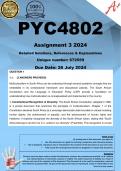PYC4802
Assignment 3 2024
Detailed Solutions, References & Explanations
Unique number: 672559
Due Date: 26 July 2024
QUESTION 1
1.1. (2 ANSWERS PROVIDED)
Multiculturalism in South Africa can be understood through several academic concepts that are
embedded in its constitutional framework and educational policies. The South African
Constitution and the Language in Education Policy (LiEP) provide a foundation for
understanding how multiculturalism is conceptualized and implemented in the country.
1. Constitutional Recognition of Diversity: The South African Constitution, adopted in 1996,
is a pivotal document that enshrines the principles of multiculturalism. Chapter 1 of the
Constitution declares South Africa as a sovereign democratic state founded on values including
human dignity, the achievement of equality, and the advancement of human rights and
freedoms. It explicitly recognizes the diversity of the South African nation, stating that "South
Africa belongs to all who live in it, united in our diversity" (Preamble). This recognition is crucial
as it lays the groundwork for policies that embrace and celebrate cultural, linguistic, and religious
diversity.
Terms of use
By making use of this document you agree to:
• Use this document as a guide for learning, comparison and reference purpose,
• Not to duplicate, reproduce and/or misrepresent the contents of this document as your own work,
• Fully accept the consequences should you plagiarise or misuse this document.
Disclaimer
Extreme care has been used to create this document, however the contents are provided “as is” without
any representations or warranties, express or implied. The author assumes no liability as a result of
reliance and use of the contents of this document. This document is to be used for comparison, research
and reference purposes ONLY. No part of this document may be reproduced, resold or transmitted in any
form or by any means.
, +27 67 171 1739
INTRODUCTION
Eating disorders, including Anorexia Nervosa, Bulimia Nervosa, and Binge-Eating
Disorder, are complex mental health conditions characterized by severe disturbances
in eating behaviors and body image. This assignment aims to provide a
comprehensive overview of these disorders by delineating their diagnostic criteria and
hallmark features. Additionally, it will critically examine the emerging trend of eating
disorders among South African black females, challenging the historical perception
that they are "immune" to these conditions. The discussion will be grounded in recent
research and sociocultural analysis, highlighting the shifting dynamics in prevalence
and manifestation. Furthermore, the assignment will adhere to the APA referencing
style, ensuring academic rigor and proper citation of sources, while incorporating the
student’s own references to enrich the discussion. This structured approach will offer
a nuanced understanding of eating disorders and their broader implications in diverse
populations.
QUESTION A
DIAGNOSTIC CRITERIA AND HALLMARK FEATURES OF ANOREXIA NERVOSA,
BULIMIA NERVOSA AND BINGE-EATING DISORDER
Understanding the diagnostic criteria and hallmark features of Anorexia Nervosa,
Bulimia Nervosa, and Binge-Eating Disorder is essential for accurate diagnosis and
effective treatment. These eating disorders are complex conditions that significantly
impact physical health, psychological well-being, and overall quality of life.
Anorexia Nervosa
Diagnostic Criteria
Anorexia Nervosa (AN) is defined by severe restrictions in food intake, leading to
significantly low body weight in the context of age, sex, developmental trajectory, and
physical health. According to the DSM-5, the diagnostic criteria include an intense fear
of gaining weight or becoming fat, even though underweight, and a disturbance in the
way one's body weight or shape is experienced. This often involves a persistent lack
Disclaimer
Extreme care has been used to create this document, however the contents are provided “as is” without
any representations or warranties, express or implied. The author assumes no liability as a result of
reliance and use of the contents of this document. This document is to be used for comparison, research
and reference purposes ONLY. No part of this document may be reproduced, resold or transmitted in any
form or by any means.





